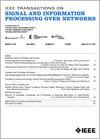Fuzzy Aggregation and Label Propagation Based Social Community Detection Using Cuckoo Search
IF 3
3区 计算机科学
Q2 ENGINEERING, ELECTRICAL & ELECTRONIC
IEEE Transactions on Signal and Information Processing over Networks
Pub Date : 2025-03-07
DOI:10.1109/TSIPN.2025.3548427
引用次数: 0
Abstract
A node in a social network is not part of just a cohesive group; it may be classified in many close or different communities. The community detection problem in social networks is similar to the clustering in networks where information is stored in node attributes and network structures. The Node-based features are often used in unsupervised algorithms that partially detect the local and overlapping communities. Networks displaying a community structure may exhibit hierarchical communities as well. Identification of hierarchical communities with community structure is a challenging task. This paper presents a two-step framework, i.e., aggregation and label propagation, to identify crisp and non-overlapping communities. Aggregation is an expansion-dissolution technique that results in crisp communities that don't require any prior information. We initially estimated random communities for each node and applied aggregation to improve them. The second step is the label propagation-based objective maximization method that takes improved crisp communities as fuzzy matrices and results in non-overlapping communities. The label propagation method is a label update mechanism for nodes with neighbors in a different community. The Label propagation function is maximized using cuckoo search and reported optimized communities. The two-step framework is empirically tested on real and simulated social networks. A comparative and contrast study is performed using performance and accuracy-based metrics to validate the framework and is found to be state-of-the-art.基于模糊聚合和标签传播的杜鹃搜索社会社区检测
社交网络中的一个节点并不只属于一个有凝聚力的群体,它可能被归类到许多相近或不同的社区中。社交网络中的社群检测问题类似于网络中的聚类问题,其中的信息存储在节点属性和网络结构中。基于节点的特征常被用于无监督算法,以部分检测局部和重叠的社群。显示社群结构的网络也可能表现出分层社群。识别具有群落结构的分层群落是一项具有挑战性的任务。本文提出了一个两步框架,即聚合和标签传播,用于识别清晰的非重叠群落。聚合是一种不需要任何先验信息就能得到清晰社群的扩展-解散技术。我们最初为每个节点估算随机群落,然后应用聚合来改进它们。第二步是基于标签传播的目标最大化方法,该方法将改进后的清晰社区作为模糊矩阵,从而得到非重叠社区。标签传播方法是一种标签更新机制,适用于与不同社区有邻居的节点。标签传播函数通过布谷鸟搜索实现最大化,并报告优化后的社区。在真实和模拟社交网络上对两步框架进行了实证测试。使用基于性能和准确度的指标进行了对比研究,以验证该框架的有效性,结果发现该框架是最先进的。
本文章由计算机程序翻译,如有差异,请以英文原文为准。
求助全文
约1分钟内获得全文
求助全文
来源期刊

IEEE Transactions on Signal and Information Processing over Networks
Computer Science-Computer Networks and Communications
CiteScore
5.80
自引率
12.50%
发文量
56
期刊介绍:
The IEEE Transactions on Signal and Information Processing over Networks publishes high-quality papers that extend the classical notions of processing of signals defined over vector spaces (e.g. time and space) to processing of signals and information (data) defined over networks, potentially dynamically varying. In signal processing over networks, the topology of the network may define structural relationships in the data, or may constrain processing of the data. Topics include distributed algorithms for filtering, detection, estimation, adaptation and learning, model selection, data fusion, and diffusion or evolution of information over such networks, and applications of distributed signal processing.
 求助内容:
求助内容: 应助结果提醒方式:
应助结果提醒方式:


